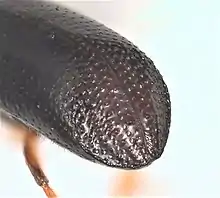Xyleborus glabratus
Xyleborus glabratus (the redbay ambrosia beetle) is a type of ambrosia beetle invasive in the United States. It has been documented as the primary vector of Raffaelea lauricola, the fungus that causes laurel wilt, a disease that can kill several North American tree species in the family Lauraceae, including redbay, sassafras, and avocado.[1][2]
| Xyleborus glabratus | |
|---|---|
 | |
| Scientific classification | |
| Kingdom: | |
| Phylum: | |
| Class: | |
| Order: | |
| Family: | |
| Subfamily: | |
| Genus: | |
| Species: | X. glabratus |
| Binomial name | |
| Xyleborus glabratus Eichhoff, 1877 | |
Distribution
Xyleborus glabratus is native to Asia, including India, Japan, Myanmar, and Taiwan.[3] It was first detected in the United States in 2002,[4] and may have arrived in wood products, packing materials or pallets.[3] X. glabratus and laurel wilt disease have since spread through much of the Gulf and Atlantic Coastal Plains, ranging from eastern Texas and Arkansas to North Carolina, and in 2019 they were found in Kentucky and Tennessee.[5]
Identification
Adult


The female redbay ambrosia beetle is a small (2.1 to 2.4 mm long), black or amber-brown, cigar-shaped beetle. The dorsal surface is mostly hairless and shiny when compared to other ambrosia beetles.[6] They can be specifically identified by characters present on the elytral declivity, including its steep and convex shape when compared to other Xyleborus, and by the large size of indentations on the elytra.[7]
Biology
The redbay ambrosia beetle is believed to originate from Asia or southeast Asia.[6] Males are haploid, smaller in size, and flightless. The beetle's biology is poorly documented, but presumed to be similar to that of other ambrosia beetles, with larvae and adults feeding on the symbiotic fungus it carries with it, and not the wood of the host tree. The spores of the fungus are carried in mycangia at the base of each mandible.
Larval development time takes from fifty to sixty days.[1] Studied populations increase steadily in size until late summer and early fall without distinct population peaks, leading researchers to believe that there are overlapping generations with year-round reproduction for the insect.[1]
History of expansion
The redbay ambrosia beetle can spread in at least two ways: one is via the beetle's natural reproduction and migration. A second way is through the sale and transport of beetle-infested wood, a result of redbay's use as firewood and for outdoor grilling.[9]
The beetle was first detected in the United States in 2002, in Port Wentworth, Georgia.[4][6] It has been suggested that this insect was introduced to the country on the wood of packing crates.[10] The significance of these detections became apparent when the beetle was linked to and identified as the vector of laurel wilt, a fungal disease that had been killing large numbers of redbay trees.[11] The fungus grows throughout the xylem of the tree, preventing the flow of water and nutrients throughout the plant. Death can occur from four to eleven weeks after inoculation.[12]
References
- Hanula, JL; Mayfield, AE; Fraedrich, SW; Rabaglia, RJ (2008). "Biology and host associations of Redbay Ambrosia Beetle (Coleoptera: Curculionidae: Scolytinae), exotic vector of laurel wilt killing redbay trees in the southeastern United States". Journal of Economic Entomology. 101 (4): 1276–1286. doi:10.1603/0022-0493(2008)101[1276:bahaor]2.0.co;2. PMID 18767737.
- "Laurel Wilt". Gallery of Pests. Don't Move Firewood. Retrieved 7 November 2011.
- Ellis, A.M.; Hodges, A.C.; Mayfield III, A.E. "Xyleborus glabratus". BugwoodWiki. Center for Invasive Species and Ecosystem Health at the University of Georgia. Retrieved 22 November 2019.
- Rabaglia, R. (2005). "Exotic Forest Pest Information System for North America. Xyleborus glabratus".
- USDA Forest Service. "Distribution of Counties with Laurel Wilt". Southern Forest Health. Southern Regional Extension Forestry. Retrieved 22 November 2019.
- Rabaglia, R. J.; Dole, S. A.; Cognato, A. I. (2006). "Review of American Xyleborina (Coleoptera: Curculionidae: Scolytinae) occurring north of Mexico, with an illustrated key" (PDF). Annals of the Entomological Society of America. 99 (6): 1034–1056. doi:10.1603/0013-8746(2006)99[1034:roaxcc]2.0.co;2.
- Rabaglia, R. (2008) [2003a]. "Exotic Forest Pest Information System for North America: Xyleborus glabratus". North American Forest Commission.
- Brar, Gurpreet S.; Capinera, John; Kendra, Paul; McLean, Stephen (2013). "Life cycle, development, and culture of Xyleborus glabratus (Coleoptera: Curculionidae: Scolytinae)". Florida Entomologist. 96 (3): 1158-1167. doi:10.1653/024.096.0357. S2CID 85794442.
- "Disease Killing Redbay Trees Makes First Appearance in Mississippi" (PDF). Mississippi Department of Agriculture. 12 August 2009.
- Haack, R.A. (2003). "Intercepted Scolytidae (Coleoptera) at U.S. ports of entry: 1985–2000". Integrated Pest Management Reviews 6: 253–282 (2001).
- Fraedrich, S. W.; Harrington, T. C.; Rabaglia, R. J.; Ulyshen, M. D.; Mayfield III, A. E.; Hanula, J. L.; Eickwort, J. M.; Miller, D. R. (2008). "A fungal symbiont of the redbay ambrosia beetle causes a lethal wilt in redbay and other Lauraceae in the southeastern USA". Plant Dis. 92 (2): 215–224. doi:10.1094/PDIS-92-2-0215. PMID 30769391.
- Mayfield, AE; Pena, JE; Crane, JH; Smith, JA; Branch, CL; Ottoson, ED; Hughes, M. (2008). "Ability of the redbay ambrosia beetle (Coleoptera: Curculionidae: Scolytinae) to bore into young avocado (Lauraceae) plants and transmit the laurel wilt pathogen (Raffaelea sp.)". Florida Entomologist. 91 (3): 485–487. doi:10.1653/0015-4040(2008)91[485:aotrab]2.0.co;2.
External links
- https://web.archive.org/web/20090616173240/http://www.fs.fed.us:80/r8/foresthealth/laurelwilt/index.shtml
- https://web.archive.org/web/20090722014653/http://www.doacs.state.fl.us:80/pi/enpp/ento/x.glabratus.html
- More images
- Xyleborus glabratus on the UF / IFAS Featured Creatures Web site
- "Farewell to taco topping?" – [Ambrosia beetle] spreads Laurel Wilt